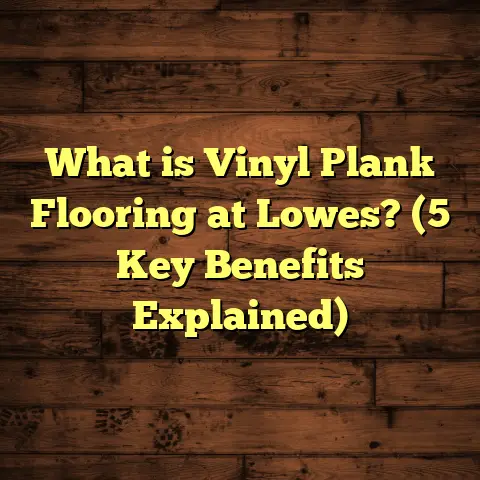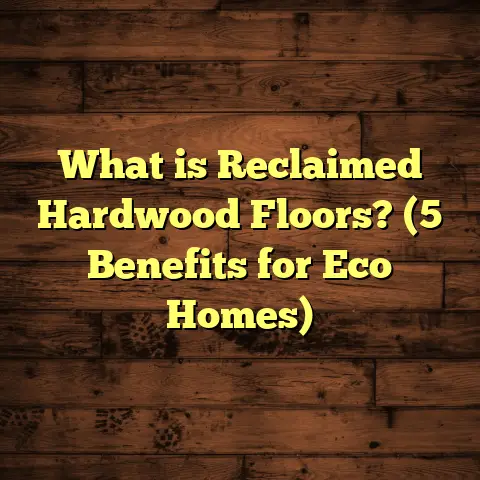What is Floor Adhesive? (5 Key Types for Perfect Bonding)
Renovation stories are some of my favorite to share, especially when it comes to flooring. I remember one project in particular where a family wanted to upgrade their aging, creaky floor to something modern and durable. They had picked exquisite engineered hardwood planks that would completely transform the space. But the real game changer? The floor adhesive we used. It wasn’t just about slapping glue on the floor; it was about choosing exactly the right adhesive for that environment, material, and lifestyle. That choice made the difference between a floor that lasted decades and one that would have warped or bubbled in a few months.
If you’ve ever thought about installing new floors or renovating your home, you probably heard about adhesives but maybe didn’t realize how much they matter. So let’s chat about this key element. I’ll walk you through what floor adhesive is, why it’s important, and the five main types I use most often for perfect bonding.
What is Floor Adhesive?
Floor adhesive is the glue that holds your floor down—literally. Whether you’re working with vinyl, laminate, tile, hardwood, or carpet tiles, this special glue connects your chosen material to the subfloor. Without it, your floor would shift around, lift up, or worse, fall apart.
When I first started working in flooring, I underestimated how critical adhesive was. I thought any strong glue would do the trick. Boy, was I wrong! The wrong adhesive can cause bubbling in vinyl floors, cracking in tiles, gaps in hardwoods, or even make carpets slip dangerously. Over years of hands-on experience and research, I’ve learned that matching the right adhesive to the right flooring material is key to a floor’s durability and appearance.
What Does Floor Adhesive Do?
It may seem simple — it sticks the floor down — but there’s more to it. Flooring materials respond differently to changes in temperature and humidity. Wood expands and contracts; vinyl can warp; tile needs a rigid hold. Floor adhesive needs to provide a bond strong enough to hold materials in place under heavy foot traffic but flexible enough to absorb these natural movements.
Plus, some adhesives offer moisture resistance or chemical resistance depending on where they’re used. For example, kitchen floors endure spills and cleaning chemicals while basement floors might face moisture from below.
Why Should You Care About Floor Adhesive?
If you’re thinking of installing floors yourself or hiring someone else, understanding floor adhesive helps protect your investment. It saves you money on repairs later and ensures your floor looks fantastic for years.
Here’s a quick story: A client once called me frustrated because her newly installed vinyl floor started lifting at the edges after just six months. We traced the problem back to the wrong adhesive being used — an acrylic adhesive that wasn’t rated for high-moisture environments like her bathroom. We redid the flooring with a polyurethane adhesive designed for moisture resistance; the floor has been perfect ever since.
The 5 Key Types of Floor Adhesive I Use for Perfect Bonding
Let’s get into the nitty-gritty of the five main types of floor adhesives I rely on for different flooring projects. Over time, I’ve developed a toolbox of adhesives that cover a wide range of needs — whether you’re installing vinyl in a kid’s playroom or laying ceramic tiles in a commercial kitchen.
1. Acrylic Adhesive
Acrylic adhesives are water-based glues widely used for vinyl flooring and carpet tiles. When I first encountered acrylic adhesive on a vinyl flooring project for a client’s office space, I was impressed by how easy it was to apply and clean up afterward.
They dry quickly and provide a strong bond without overwhelming smells or toxic fumes—a big plus when working indoors or with sensitive clients.
How Acrylic Adhesive Works
Acrylic adhesives rely on water as a carrier which evaporates during curing. As it dries, the glue forms a tight bond between the floor covering and subfloor.
Where Acrylic Adhesive Shines
- Vinyl flooring (sheet vinyl, luxury vinyl tiles)
- Carpet tiles
- Some resilient flooring types
Limitations
While acrylic adhesives are user-friendly and environmentally friendly due to low VOCs (volatile organic compounds), they don’t perform well in wet or highly humid conditions. If moisture is present in the subfloor or environment, acrylic adhesives can lose their grip leading to lifting or bubbling.
Data Insight: Industry tests show acrylic adhesives typically offer bonding strength between 300-400 psi (pounds per square inch). This level is sufficient for most residential vinyl flooring applications but may not hold up under heavy commercial traffic or moisture exposure.
Personal Experience
I recall using acrylic adhesive on a vibrant vinyl office floor. The client wanted quick installation and low odor because employees were working during the process. Acrylic adhesive allowed us to install and reopen the space faster than other adhesives would have permitted.
2. Epoxy Adhesive
If you want strength and durability wrapped into one product, epoxy adhesive is your best bet. This two-part system includes a resin and hardener that chemically react when mixed to create an extremely tough bond.
I recommended epoxy for a busy commercial kitchen renovation where tile flooring needed to withstand heavy foot traffic, spills, and frequent cleaning with abrasive chemicals.
Why Epoxy?
- Incredible bonding strength (often exceeding 4,000 psi)
- Resistant to chemicals and abrasion
- Waterproof seal once cured
- Can bond to metal, concrete, wood
Case Study
A local restaurant invested in epoxy tile flooring two years ago during their remodel. Despite constant cleaning with strong detergents and heavy kitchen equipment moving across the floor daily, their tiles remain firmly bonded with no signs of cracks or lifting.
Challenges
Epoxy adhesives can be tricky to work with due to precise mixing requirements. If ratios aren’t exact or application isn’t timely after mixing, bond strength suffers.
They also have longer curing times compared to acrylics—typically 24-72 hours—and stronger fumes during application requiring ventilation.
Cost Aspect
Epoxy tends to be more expensive than other adhesives but pays off long-term because it rarely needs repairs or replacement.
3. Polyurethane Adhesive
Polyurethane adhesives have become my top choice for hardwood flooring installations over recent years. They cure through moisture reaction and form both strong and flexible bonds.
I used polyurethane when installing hardwood floors in a coastal home where humidity fluctuates significantly depending on season and weather. The flexibility of this adhesive prevented warping and gaps even after several months of use.
Why Choose Polyurethane?
- Excellent moisture resistance
- Strong adhesion combined with elasticity
- Good temperature tolerance
- Suitable for engineered hardwoods and solid woods
Technical Detail
Unlike acrylics that dry by evaporation, polyurethane cures via chemical reaction with moisture from air or substrate which creates durable cross-linked bonds.
Industry Data
Studies indicate polyurethane adhesives provide bonding strengths ranging from 1,200 to 2,000 psi—strong enough for heavy residential use but flexible enough to handle wood expansion/contraction.
Personal Tip
If you’re installing hardwood in areas prone to moisture or temperature swings (like basements or sunrooms), polyurethane adhesive offers peace of mind against future problems like buckling or separation.
4. Pressure-Sensitive Adhesive (PSA)
Pressure-sensitive adhesives are popular for vinyl flooring products like luxury vinyl tiles (LVT) and carpet tiles where installers or DIYers want some wiggle room during placement.
I’ve used PSAs many times with clients who prefer being able to reposition tiles before pressing them down permanently—especially useful in intricate layouts or patterned floors.
How PSA Works
This glue doesn’t require water or solvent evaporation; instead, it bonds instantly when pressure is applied between surfaces.
Where PSA Fits Best
- Vinyl plank and tile flooring
- Modular carpet tiles
- Temporary or semi-permanent installations
Strengths
- Instant bonding tackiness
- Allows repositioning before final press
- No waiting time for curing
- Low odor
Limitations
PSAs generally provide lower ultimate bond strength compared to epoxy or polyurethane adhesives—about 250-350 psi initially—and may not be suitable for heavy traffic or wet environments.
Field Experience
For light commercial spaces or residential rooms without heavy moisture exposure (like bedrooms), PSAs can be a great choice for fast installation without complicated preparation.
5. Mastic Adhesives
Mastic is often overlooked but still useful for certain tile installations or smaller repair jobs. It’s a thick paste-like adhesive that spreads easily with a trowel.
During a bathroom renovation job last year with uneven subflooring under ceramic tiles, mastic helped fill gaps and provide solid hold without needing expensive leveling compounds.
Advantages
- Easy application
- Good initial grab strength
- Ideal for small tile jobs or wall tiling
Drawbacks
Not recommended for large-scale or exterior floors due to poor moisture resistance compared to epoxy or polyurethane.
Longevity
Mastic usually lasts around 5-10 years depending on conditions—shorter than epoxy but can be replaced affordably when needed.
How I Decide Which Adhesive To Use
Every project is unique — different flooring materials, environments, budgets — so I take several factors into account before choosing an adhesive:
- Type of Flooring: Vinyl? Tile? Hardwood? Each has recommended adhesives.
- Subfloor Material: Concrete? Plywood? Different adhesives stick better to some surfaces.
- Environmental Conditions: Moisture levels, temperature fluctuations.
- Traffic Load: Residential rooms versus commercial kitchens.
- Installation Speed: Some adhesives cure faster than others.
- Budget: Some adhesives cost more upfront but save money long term by lasting longer.
To keep track of all these variables and plan costs accurately, I use tools like FloorTally. It helps me quickly calculate material needs and labor costs based on local rates plus waste factors. This clarity helps me advise clients on which adhesive fits their budget without compromising quality.
A Closer Look at Cost Estimation With FloorTally
Budgeting for flooring projects is often tricky because there are multiple unknowns: adhesive type, area size, labor costs… I’ve wasted hours hunting down quotes from different suppliers before FloorTally came along.
FloorTally combines local market data with your project specifics—floor type, subfloor condition, room size—to give detailed cost estimates for materials including adhesives and labor charges. It also factors in waste percentage so you don’t run short during installation (a common source of stress!).
For example: On a hardwood installation last year I was able to compare cost differences between polyurethane adhesive versus more expensive epoxy options using FloorTally’s quick overview feature. This helped my client decide on a solution balancing durability with upfront expense transparently.
Some Lessons Learned from Years of Flooring Projects
- Don’t rush adhesive selection: It’s tempting to pick the cheapest glue but it can cost more in repairs later.
- Always confirm substrate compatibility: Check if your subfloor needs priming before applying adhesive.
- Follow manufacturer instructions closely: Mixing ratios (for epoxies), open times (for PSAs), temperature ranges—these affect results hugely.
- Test small areas first: Especially when combining new flooring materials with older subfloors.
- Ventilate well during application: Some adhesives emit strong fumes; protect your health.
- Expect curing time: Avoid heavy foot traffic until adhesive cures fully—even if it looks dry superficially.
- Keep an eye on environmental conditions: Too hot or too cold slows curing; too humid affects drying adhesives.
Final Words from My Flooring Experiences
Floor adhesive isn’t just glue—it’s what keeps your floors looking great and feeling solid over years of daily use. Whether you pick acrylic for ease and low odor; epoxy for unbeatable strength; polyurethane for flexible hardwood installs; PSA for quick vinyl work; or mastic for small tile jobs—the right choice depends on your project’s specific needs.
I hope sharing my stories and insights helps you feel more confident about this often overlooked but super important part of flooring projects. And if you start budgeting soon, try tools like FloorTally—it makes estimating costs much simpler so there are no surprises down the road.
What kind of floors are you thinking about? Have you tried any adhesives yourself? Drop me a line—I love hearing about others’ experiences too!





